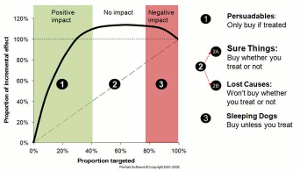
Most successful companies invest in marketing. Marketing budgets are utilized differently depending on factors such as industry and company goals, and results are contingent on how well an organization understands and interacts with its customers. However, what many organizations don’t know is that often they could be getting the same — or better — outcomes by spending a lot less.
By obtaining a clear picture of individual customers and their personal needs and preferences, companies are able to greatly reduce their marketing budgets and produce improved results by only approaching customers with relevant offers.
So, how do marketers obtain and capitalize on individual customer information?
Integrating intelligent analytics into a marketing campaign provides marketers with accurate, in-depth information that allows them to approach each customer with only targeted, relevant offers that address the individual’s specific wants and needs.
Uplift modeling is an analytic approach to marketing that predicts the difference that a marketer’s actions will make on the behavior of customers, as opposed to predicting customer actions that would have happened with or without the marketing treatment. With this insight, marketers can determine if reaching out to individual customers is worth the investment — or if the outreach simply equates to time and money lost.
Segmentation Is Key
Uplift uses predictive analytic techniques to divide an audience into distinct segments. This allows marketers to focus efforts only on the “Persuadables” — those who are likely to respond to a marketing outreach by buying (or renewing), but wouldn’t have if they weren’t contacted.
Similarly, uplift modeling prevents businesses from wasting time and money targeting customers who are already a “Sure Thing” and will buy regardless, as well as those who are a “Lost Cause” and will never buy no matter what offer they receive. This approach also helps marketers avoid the “Sleeping Dogs” — those customers who don’t want to be disturbed and are likely to react negatively to marketing outreach by perhaps opting out of marketing lists or even taking their business elsewhere.
Using this next level of customer response segmentation not only reduces the amount of money that organizations spend on outreach, but also helps reduce a company’s cost of fulfillment, as it prevents marketers from giving away special offers or incentives to customers who were going to buy or renew anyway, and would have done so at full price.
Uplift modeling enables companies to focus on targeting the “Persuadables,” or those who, on being treated, will respond positively and result in incremental sales — while ignoring the negative outcomes of targeting everyone else.
Added Perk
Uplift modeling both reduces campaign costs and increases marketing campaign ROI. However, another positive result of audience segmentation and targeting is that it fosters green marketing practices.
By knowing who to target with direct marketing collateral and who to avoid, companies are able to greatly reduce the volume of printed marketing materials that they produce, which equates to a positive perk that they can boast about.
These days, going green is a selling point. Often, it comes at a price, but with uplift modeling, green marketing is actually achieved through cost savings.
Case in Point
Uplift modeling, although a relatively new technology, has already proven its value for many companies. A major bank, for example, has seen significant results since incorporating uplift modeling into its marketing strategy. The company utilized the modeling techniques within both the deposit and credit sides of its consumer banking business, and its results delivered an increase of more than US$1 million increase in incremental revenue from just two campaigns. One of those campaigns achieved a 189 percent year-on-year increase in incremental responses coupled with a reduction in mailing volumes by 20 percent — further increasing campaign profitability.
In a second notable success, the bank used uplift modeling for take-up of its direct deposit accounts. The results were a 73 percent increase in incremental accounts opened from a single campaign, together with a 32 percent reduction in mailing volumes.
A Fortune 50 retail electronics company also experienced great success with uplift technology. The company used uplift modeling to increase the incremental revenue delivered by monthly catalog mailings compared to existing response and value-based targeting. Through this process, the organization was able to increase its revenue by $2.5 million per month with a reduced volume of better targeted mailings.
When it comes to making the most of a marketing budget, ensuring that a campaign is targeted and relevant for individual customers is an overarching theme. Blanket, untargeted marketing campaigns can be extremely costly and will fail to produce impressive results.
Incorporating uplift modeling technology, based on intelligent analytics, into a company’s marketing strategy ensures that it will invest only in contacting customers who will react positively to its outreach, avoiding those who won’t be influenced by its efforts and may even react negatively.
Segmenting in this way helps ensure higher marketing campaign ROI and lower customer churn — two key goals for any successful business.
Mark Smith is executive vice president of sales and marketing at Portrait Software , a provider of customer interaction optimization software.




































Social Media
See all Social Media